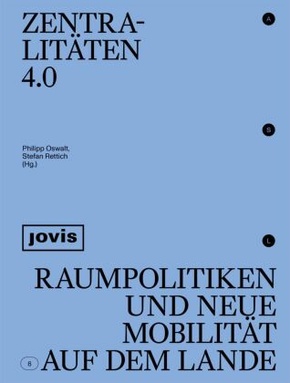
Zentralitäten 4.0 - Raumpolitiken und neue Mobilität auf dem Lande
| Verlag | Jovis |
| Auflage | 2023 |
| Seiten | 280 |
| Format | 17,2 x 2,0 x 22,8 cm |
| Großformatiges Paperback. Klappenbroschur | |
| Gewicht | 652 g |
| ISBN-10 | 3868596224 |
| ISBN-13 | 9783868596229 |
| Bestell-Nr | 86859622A |
Walter Christaller hat in den 1930er Jahren zur Bestimmung seines Zentrale-Orte-Systems neue Medien herangezogen: Er zählte Telefonanschlüsse, um raumübergreifende Zentralitäten zu identifizieren. Heute wirkt sich Digitalisierung prägend auf den Raum aus, auf Stadt, Land und Mobilität - oder erzeugt Disruptionen, wo sie fehlt. Einleitend beleuchten Beiträge die Wirkweise von Digitalisierung auf den Raum und befassen sich mit der Aktualität des Zentrale-Orte-Systems. Dies wird theoretisch, aber auch praktisch an Hand von Raumpolitiken aktueller Landesentwicklungsprogramme, unterschiedlicher Auffassungen von Daseinsvorsorge sowie den Aufgaben von Mittelzentren in städtisch und ländlich geprägten Räumen erörtert. Im zweiten Teil wird diskutiert, welche strukturellen Veränderungen im Zuge der Digitalisierung - insbesondere durch neue Mobilität - zu erwarten sind und wie sich diese auf die Attraktivität des ländlichen Raums und die Aufgaben von Mittelstädten auswirken könnten. Abs chließend werden die Ursachen populistischer Tendenzen, Verlusterfahrungen durch Globalisierungsprozesse und soziale Spaltung sowie rechtsextreme Entwicklungen im ländlichen Raum beleuchtet.
In the 1930s, Walter Christaller used new media to work out his central place theory by counting telephone lines to identify centralities that connected multiple spaces: Today, digitization has a formative effect on space-on cities, the countryside, and mobility. Or when it is lacking, disruptions are the result. The contributions to the book offer an introductory examination of the effects of digitization on space and deal with the topicality of Christaller's central place theory. The book does so both theoretically and practically, by examining spatial policies of current regional development programs, different conceptions of public services, and the tasks medium-sized centers in urban and rural areas. The second part of the book discusses which structural changes are to be expected in the course of digitization, especially through new mobility, and how this might affect the attractiveness of rural areas and the tasks of medium-sized towns. Finally, it examines the causes of populist tendencies and experiences of loss produced by processes of globalization and social division, as well as right-wing extremist developments in rural areas.
